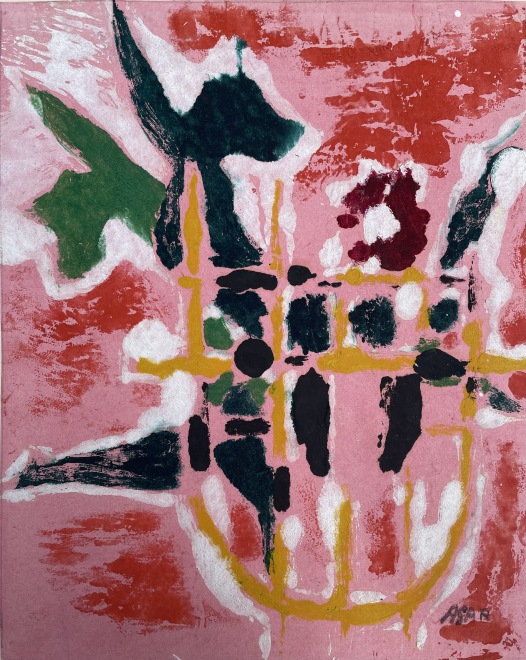Eileen Agar
Still Life Composition, c. 1952
Signed
Monotype with hand-finishing on coloured sugar paper, laid down on corners to card. A unique work.
10 x 8 inches
Provenance
Collection of Blair Hughes-Stanton (1902 -1981)
Note: Eileen Agar first met the artist Blair Hughes-Stanton in 1920 while both were attending the esteemed sculptor and printmaker Leon Underwood’s Brook Green School of Art in west London. While there, through Underwood's tutelage the small group of students including Henry Moore and later Gertrude Hermes developed a unique visual language for their time. Underwood emphasised subject and rhythm, while encouraging students to create works that celebrated love and physicality.
Agar is now recognised as one of the leading British Surrealists. Her inclusion within the 1936 International Surrealist Exhibition, selected by Herbert Reid and Roland Penrose holds her place amongst her European peers within the movement. Acknowledged as so, Agar has been included within the majority of international exhibitions reappraising and surveying Surrealism and its legacy within 20th Century.
Rare within Agar's oeuvre, the theme and subject for 'Still Life’, gifted by the artist to Hughes-Stanton and most probably created in his company, is still recognisably imbued with Agar’s warmth and interest in the naive. It was almost certainly created in the early 1950s, when Agar was still in touch with Hughes-Stanton. It’s medium as a monotype again is almost unique to Agar’s output and again almost certainly guided by Hughes-Stanton’s own first experiments in Monotype in the early 1950s. The use of the technique ‘monotype', in which an image is created from an inked-up or painted plate, then impressed to chosen surface, was one widely used by 20th Century’s European Modernist movement. Monotype's unique attraction as a medium is it’s element of chance and experimentation, famous exponents of the technique being Paul Klee, Miro, Dubuffet and Agar’s friend Picasso.
The two techniques most commonly associated with Agar’s 2 dimensional works are collage and Frottage, which she used with great success throughout her career. Both techniques need few materials, are quick to execute and again like monotype offer an element of chance, a subconscious third hand, if you will. ’Still Life’ is a very rare example of a monotype by Agar, an artist, always experimenting, changing, growing and restless until the end.
Hughes Stanton went on to become internationally renowned for his wood engravings, later winning the Venice Biennale and importantly working alongside his close friends D.H. Lawrence and T.E. Lawrences to illistrate 'Seven Pillars of Wisdom’.
